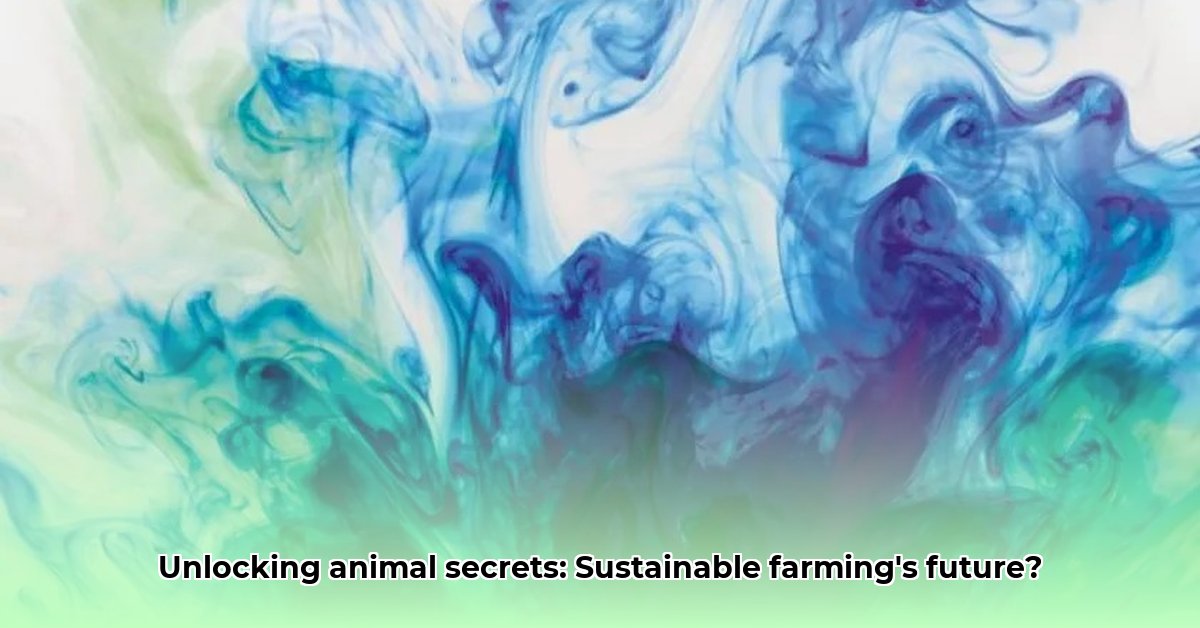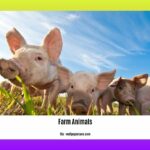Have you ever wondered if your dog truly understands your sadness or if a cow feels pain as we do? For too long, animals have been treated as machines, their feelings disregarded. However, groundbreaking scientific discoveries reveal an astounding truth: animals possess intricate emotions mirroring our own. This exploration transcends mere “cute” animal videos, delving into rigorous scientific research demonstrating animals’ capacity for experiencing joy, fear, sadness, and even love. Join us as we explore the compelling evidence of animal sentience, examining diverse animal experiences and highlighting how we can forge a compassionate, sustainable food system prioritizing animal well-being.
The Journey into Sentience: Unveiling Complex Emotions in the Animal Kingdom
For centuries, debate has raged over whether animals truly feel – whether they experience the range of emotions, from joy and sadness to fear. This isn’t just a philosophical question; it strikes at the heart of how we treat the creatures with which we share our planet. Increasingly, scientific research provides a resounding answer: yes, animals possess rich inner lives. Backed by solid data, this isn’t some sentimental, anthropomorphic projection, but a demonstration that animals are not merely automatons reacting to stimuli. The implications of this newfound understanding of animal behavior are profound, demanding a re-evaluation of our farming practices and their impact on both our food systems and animal welfare.
Beyond Simple Reactions: The Mounting Evidence of Animal Emotions
Scientists are continually revealing a deeper understanding of the intricate emotional lives within the animal kingdom. Studies reveal joy in playful interactions, grief in the wake of loss, fear when facing danger, and even empathy, where an animal appears to recognize and respond to the emotional state of another. This isn’t limited to mammals; birds, insects, and even invertebrates exhibit signs of sophisticated emotional capabilities. Observe a dog’s excited tail wags, a cat’s purring contentment, or a flock of birds moving in coordinated flight. These behaviors are more than mere reflexes; they suggest a profound emotional intelligence. While their experiences may not mirror our own, they possess rich and nuanced emotional lives. Ongoing research is solidifying the evidence for sophisticated emotional capacity in animals.
The Emotional Landscape of Farmed Animals: Welfare Considerations
Historically, animal welfare efforts prioritized minimizing negative experiences, such as pain, confinement, and fear. While reducing animal suffering is undeniably crucial, focusing solely on the negative overlooks a critical aspect: animals also experience positive emotions. A content cow, well-fed and comfortably socializing with her herd, is fundamentally different from one crammed into a cramped barn, stressed and anxious. A comprehensive understanding of animal sentience necessitates prioritizing positive emotions alongside preventing negative ones. An ethical approach to animal care should aim to provide lives rich in positive experiences, not merely free from pain, by enriching their lives holistically through mental and physical enrichment.
Transforming Farms: Sentience and Sustainable Agricultural Practices
This evolving understanding of animals carries significant weight for sustainable farming. Traditional intensive farming crams animals into small spaces, depriving them of natural behaviors and environmental stimulation. These practices are not only inhumane, but unsustainable – stress and anxiety can compromise animal health and productivity. Animal sentience challenges us to rethink these systems entirely, offering regenerative and agroecological farming as a more humane and sustainable alternative. Emphasizing biodiversity, soil health, and animal welfare, these approaches provide animals with more space and freedom, encouraging natural behaviors and enriching environments, ultimately leading to happier, healthier animals. The benefits extend to the environment and human communities, promoting a balanced ecosystem.
Practical Steps Towards a Brighter Future: A Path Forward
Transitioning to a more humane and sustainable agricultural system requires a multi-faceted approach, with contributions from consumers, farmers, policymakers, and researchers. While it’s a formidable challenge, it’s a pathway to future food systems with potential benefits.
Empowering Farmers and Producers:
- Enhance housing conditions by expanding space and providing mental and physical enrichment.
- Adopt advanced pain management strategies to alleviate animal suffering.
- Transition to agroecological farming practices, prioritizing soil health and biodiversity.
Guiding Policy Makers and Regulators:
- Strengthen animal welfare laws, integrating scientific evidence on animal sentience.
- Invest in research focused on enhancing positive animal welfare.
- Incentivize sustainable and humane practices through measures like carbon credits or tax breaks.
Informing and Engaging Consumers:
- Actively seek out higher-welfare products, supporting farms that prioritize animal well-being.
- Educate yourself about food origins and animal raising practices.
- Advocate for stronger regulations on intensive farming practices.
Focusing Research Efforts:
- Improve methodologies for measuring and understanding positive animal welfare.
- Expand research to encompass a wider range of species, especially those currently underrepresented.
- Develop standardized metrics for assessing positive animal welfare, enabling consistent comparisons and informed analysis.
Building a Better Future Together: A Shared Responsibility
Animal sentience is more than an academic debate; it’s a profound ethical matter deeply entwined with the future of sustainable agriculture. Acknowledging and respecting the emotional complexity of animals is essential for creating a fair, ethical, and sustainable food system benefiting our planet and its creatures. This collective journey requires cooperation and shared responsibility. By acting together, we can build a society where both humans and animals thrive, shaping a future built on conscious choices.
Implementing Positive Animal Welfare Measures in Regenerative Agriculture
Key Takeaways:
- Regenerative agriculture, ecologically promising, sometimes overlooks animal welfare.
- A “One Welfare” approach is crucial, integrating animal, human, and environmental well-being and promoting greater sustainability.
- Implementing positive animal welfare measures in regenerative agriculture necessitates a multi-faceted strategy to assure animal well-being and sustainability.
The Animal Sentience Puzzle: Animals within Regenerative Systems
Regenerative agriculture often evokes images of healthy soil and carbon sequestration, but do these farming methods also benefit the animals? While many assume regenerative practices improve animal welfare, concrete data remains scarce. It’s crucial to look beyond assumptions and delve into the science to understand how regenerative systems impact animal well-being.
Many regenerative farms integrate livestock and crops, offering potential synergies as animals graze, manure fertilizes, and everyone (ideally) thrives. However, this integration doesn’t guarantee high animal welfare; it requires a proactive approach that promotes animal health.
Measuring Animal Well-being: Beyond the Basics
Assessing animal welfare goes beyond basic needs like food and water, requiring us to consider behavior, stress levels, and overall health. Rigorous research, standardized methods, and collaboration are essential to transcend merely preventing suffering and actively promote positive animal experiences.
Observing a cow in a pasture reveals more than mere existence; it may demonstrate contentment through grazing, engagement in natural behaviors, and low stress. This nuanced approach is crucial for evaluating a truly “regenerative” system, allowing us to assess whether the system is simply functional, or truly beneficial to the animals.
Steps for Enhancing Animal Welfare in Regenerative Agriculture
- Research & Development: More research is needed to measure the effects of regenerative methods on animal welfare indicators, including health data, behavioral observations, and stress level analysis. The development of consistent assessment methods is crucial for reliable comparisons.
- Farmer Engagement: Farmers are key players, and their participation in research and adoption of humane husbandry practices are essential for progress. Adjustments to stocking rates, pasture management, or shelter provision can significantly impact animal welfare within existing systems.
- Consumer Awareness & Demand: Consumers drive change by demanding transparency and supporting businesses dedicated to high animal welfare.
- Policy & Regulation: Governments can fund research, incentivize high-welfare practices, and establish minimum welfare standards for regenerative agriculture, providing clear and enforceable regulations.
A Sustainable Vision for the Future
The long-term goal is a future in which regenerative agriculture is synonymous with high animal welfare. This requires sustained effort across all stakeholders to implement globally recognized standards, refine “One Welfare” frameworks, and foster research collaborations. Farmers must invest in infrastructure to support advanced animal welfare monitoring, while consumers demand high-welfare products. Creating a truly sustainable food system requires considering every part of the equation, including the wellbeing of animals.
Implementing Animal-Centric Practices in Regenerative Farming Systems
Key Takeaways:
- Regenerative agriculture’s ecological advantages are well-documented, but integrating animal welfare remains a noteworthy challenge.
- A lack of standardized animal welfare metrics hampers progress in this domain.
- Implementing Animal-Centric Practices in Regenerative Farming Systems necessitates a comprehensive strategy, acknowledging the interconnection between animal, human, and environmental well-being.
The Sentience Puzzle: Unveiling Animal Emotions in Sustainable Agriculture
While the environmental benefits of regenerative farming are clear, shouldn’t animal well-being be central to truly sustainable agriculture? Science increasingly underscores that animal sentience is an inextricable component, a reality that reduces benefits to animal well-being if ignored.
Numerous studies demonstrate a greater animal emotional depth than previously assumed. The complex social structures of sheep and the problem-solving abilities of crows suggest animals are not simply automatons, but beings capable of joy, sorrow, fear, and affection. Showcasing the complexity of emotions in different environments can improve animal well-being.
Bridging the Divide: Ethics, Science, and Sustainable Farming
The challenge lies in translating scientific understanding into practical actions within current regenerative agriculture practices that often marginalize the animals’ experience. How can environmentally friendly methods simultaneously ensure and prioritize animal welfare?
The key is implementing animal-centric practices in regenerative farming systems through the following sustainable improvements:
- Developing Standardized Metrics: We urgently need consistent ways to assess animal welfare within different regenerative farming systems by measuring key aspects of well-being, such as stress levels, health, and natural behaviors.
- Promoting Integrated Systems: Integrated crop-livestock systems offer a path toward mutual benefit, creating an environment where animals contribute to soil health while receiving optimal care, necessitating careful planning that considers animal needs and biodiversity.
- Enhancing Transparency and Certification: Certification bodies must integrate robust animal welfare standards into their frameworks, and give consumers a way to identify and support farms prioritizing both environmental sustainability and animal welfare for fostering trust and driving market demand for ethically produced food.
The Economics of Animal Welfare
Despite the perception of animal welfare as an added expense, it can drive efficiency and economic resilience. Healthy, well-cared-for animals are more productive and less prone to illness, reducing veterinary costs and enhancing overall farm profitability, particularly as growing consumer concern is shifting market demand toward ethically-sourced products.
A Call for Global Collaboration
Achieving truly regenerative systems requires collaboration from researchers, farmers, policymakers, and consumers. Through continued research, innovative animal-centric practices, supportive policies, and informed consumer choices, we can cultivate a future where food systems are for both the environment and ethics and a sustainable system for future generations.
Positive Animal Welfare Indicators in Sustainable Agriculture: A Comparative Analysis
Key Takeaways:
- Positive Animal Welfare (PAW) goes beyond preventing suffering; it’s about enriching animal lives.
- Measuring PAW is difficult, especially in diverse, low-resource settings; standardized, validated indicators are needed.
- Collaboration is essential for global PAW adoption and improved animal care.
The Sentience Puzzle: Unlocking Animal Emotions
The sight of a cow nuzzling its calf, a pig playfully exploring, or a chicken meticulously dust-bathing reveals far more than mere instincts; they hint at an inner world and emotional lives, supported by scientific evidence. This understanding is vital for Positive Animal Welfare Indicators in Sustainable Agriculture – for more ethical farming practices
Defining and Measuring Positive Animal Welfare
“Positive” animal welfare involves giving animals opportunities to express natural behaviors, fulfill biological needs, and experience positive emotions like contentment and joy. A happy, healthy animal thrives, exhibiting natural behaviors that tell a story of positive emotions.
Measuring this involves identifying indicators (like dust-bathing frequency in chickens or play behavior in pigs), and developing more standardized, validated measures, particularly for species beyond common ones, especially in low-income countries. Imagine the variation for a free-range chicken farm in Kenya versus a high-intensity poultry farm in Europe.
Global Challenges and Cultural Considerations
Born largely in high-income nations, the concept of PAW faces global hurdles, as cultural values and beliefs shape how we define and achieve positive welfare. As societal challenges and economic or religious barriers must be accounted for, comparing high-income with low-income settings requires financial investments to implement enrichment programs or ensure adequate veterinary care.
Promoting Positive Welfare: Collaborative Action
Farmers hold a critical role, as their daily interactions directly impact animal welfare. They must be empowered through education and training on PAW principles and practical implementation methods, and consumers must exercise influence through purchasing power by demanding transparency in animal welfare practices and supporting businesses committed to PAW. Enhanced collaboration can promote positive well-being for all.
We need to prioritize:
- Standardized indicators: Developing reliable indicators to assess PAW across contexts and species.
- Capacity building: Investing in education and training for farms and stakeholders in low-income countries.
- Policy changes: Integrating PAW principles into national animal welfare policies.
- Consumer engagement: Raising public awareness and promoting consumer demand for higher welfare products.
This combined effort can move beyond preventing animal suffering towards a future where animals not only survive but thrive, requiring a sustained commitment to improve the relationship with the animals we share our planet with.
-
https://pubmed.ncbi.nlm.nih.gov/380487117/] ↩
















